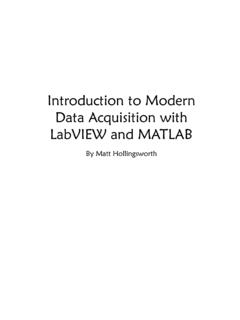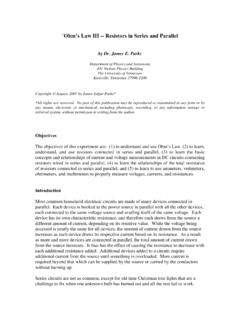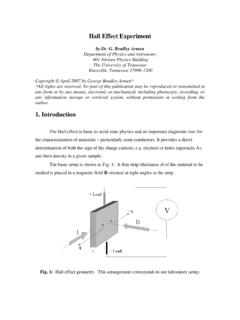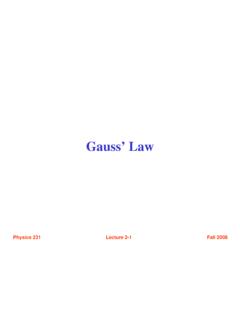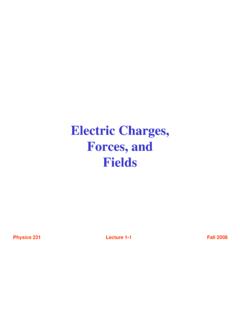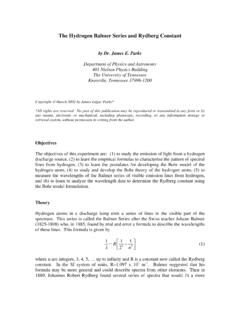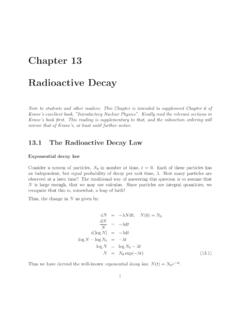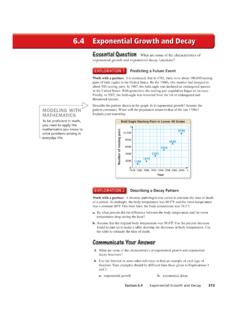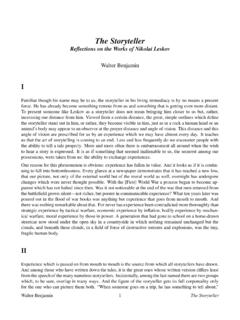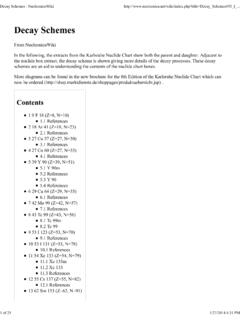Transcription of Radioactive Half-life of Barium-137m - University of Tennessee
1 Radioactive Half-life of Barium-137m by Dr. James E. Parks Department of Physics and Astronomy 401 Nielsen Physics Building The University of Tennessee Knoxville, Tennessee 37996-1200 Copyright April 2001 by James Edgar Parks* *All rights are reserved. No part of this publication may be reproduced or transmitted in any form or by any means, electronic or mechanical, including photocopy, recording, or any information storage or retrieval system, without permission in writing from the author. Objectives The objectives of this experiment are: (1) to study Radioactive decay , (2) to learn the concept of nuclear activity, (3) to learn the concept for Radioactive Half-life and how to measure it, and (4) to measure the Radioactive Half-life of an isotope of barium. Theory The activity of a Radioactive substance is the number of nuclei of atoms that decay and emit Radioactive particles per unit time. The activity of a Radioactive material depends upon the amount of material and is found to decrease with time as the atoms decay to some other state.
2 The change in the number of Radioactive nuclei that exist at anytime is equal to the number that decay by giving off Radioactive particles. The change in the number of undecayed nuclei N is proportional to the number of undecayed nuclei N and the time t over which the change takes place. This may be expressed mathematically by the difference equation -NNt = (1) where is the nuclear decay rate constant that depends on the particular isotope that is disintegrating and the type of particle that is being emitted. The rate constant is related to the probability that a particular nuclei will emit a Radioactive particle of a particular type. The negative sign indicates that the change is a decrease in the number. For infinitesimally small times this equation may be written as dNNdt = (2) Radioactive Half-life of Barium-137m and solved by the methods of calculus to yield toNNe = (3) which is the number N of undecayed nuclei at any time t when the initial number at t = 0 is No.
3 The symbol e is the natural exponential number Since the activity of a sample is the time rate of change of N, the activity A of a sample is defined by -NdNAtdtNN === = (4) and is proportional to the number of Radioactive nuclei. Since the activity is proportional to the number of Radioactive nuclei, the activity will have the same time behavior and will change at same rate as the number of nuclei. Therefore, the activity is given by toANe = (5) and toAAe = (6) where Ao is the initial activity of the sample at time t = 0, and is equal to No. The activity of a sample can be measured as a function of time and the rate constant can be determined experimentally.
4 The SI unit of activity is the becquerel and is defined as the activity of a radionuclide that has a decay rate of one spontaneous nuclear transition per second. Historically, the standard unit of activity is the Curie (Ci) and is still the most often used unit for expressing activity. One Curie is equal to x 1010 becquerels. (1 Ci = x 1010 Bq.) Typical exempt sources that can be purchased without a license have activities of a few microcuries, 10-6 Ci. A useful concept in nuclear methods is the time that it takes the activity of a given Radioactive sample to decrease by half of its original activity. This time is known as the nuclear Half-life and can be used to help identify an unknown radioisotope. The nuclear Half-life depends on the decay rate constant so that the larger the decay rate, the smaller the Half-life . The nuclear Half-life is defined such that if the initial activity is Ao at time t = 0, then the activity at time t = will be A = Ao and 12ooAAe =.
5 (7) 2 Radioactive Half-life of Barium-137m This equation may be solved for the Half-life by simplifying and taking the natural logarithm of both sides of the equation. By dividing both sides of Equation (7) by Ao and by taking the inverse of each side, Equation (7) becomes 12e = (8) and 12e = (9) and 2e =. (10) Taking the natural logarithm of each side of this equation yields ln 2 lne =, (11) ln 2 =, (12) and ln 2 =.
6 (13) Since ln 2 = , the nuclear Half-life can be computed from a measurement of the decay rate constant and the simple relationship =. (14) The decay rate constant for a particular isotope may be found by measuring the activity of a sample as a function of time and analyzing the results. When a quantity N decreases exponentially with time t as the activity A of a Radioactive sample does, a plot of Ln(N) versus t will result in points that lie along a straight line. The equation for this straight line will be of the form, toNNe =, and the decay rate constant characterizes how fast the quantity N or A changes with time and is different for different Radioactive isotopes. If the natural logarithm of N is taken, then lnlntoNNe =, (15) lnlnlntoNN e =+, (16) and lnlnoNNt =.
7 (17) 3 Radioactive Half-life of Barium-137m This equation is in the form of an equation for a straight line, y = a + bx, where y = ln N, a = ln N0, x = t, and b = - . If ln N is plotted as a function of t, then the results should be a straight line whose slope is negative and has the value . Therefore, the rate constant may be found from a plot of ln N versus t and linear regression. Apparatus The apparatus is shown in Figure 1 and consists of (1) a Nucleus scaler/timer, (2) Geiger-Mueller tube with stand and source holder, (3) a cesium/ Barium-137m isogenerator, (4) planchet, (5) a source holder tray, (6) Pasco Science Workshop 750 data interface, (7) Pasco Science Workshop software, (8) Excel software, and (9) computer system. Figure 1. Apparatus for measuring the Half-life of Ba-137m. The performance of the Geiger counter depends on the high voltage supply and that has been pre-set for this experiment.
8 Normally, an experiment would be run to determine the operating voltage, but that process has been eliminated for this experiment to concentrate on the study of the measurement of the Half-life . Unless instructed otherwise, the high voltage for the counter should be set at 900 volts. The instructor will make the Ba-137m source for each experimenter when ready. Counting should start as soon as possible after the sample is made. After the run, the planchet with the used Ba-137m source material should be placed in a baking dish in the sink to be washed. After each Ba-137m source, it takes about minutes for the Ba-137m to build back to 3/4 strength. Thus the instructor should rotate through several isogenerators for each class. Remember to wipe up any spills and to wash yourself thoroughly if any of the source material should come in contact with your skin. 4 Radioactive Half-life of Barium-137m Method In this experiment a G-M tube with a scaler/timer will be used to measure the Radioactive Half-life of an isotope of barium, Ba-137m, a metastable state of barium before it decays to its ground state.
9 The activity of the Ba-137m is measured as a function of time by detecting the gamma rays that are emitted and the Half-life is computed from the decay rate constant. The activity of the sample cannot be measured instantaneously, but instead a number of Radioactive decays are detected and counted over a series of short time intervals. It can be shown that this number changes exponentially with the same decay constant as the activity, and therefore, is equivalent to measuring the instantaneous activity. Also, the number of detected particles is a fraction of the total number of decays since the radiation is emitted from the source in all directions and the detector only intercepts a small portion of these directions. In other words, the detector only sees a small fraction of the total solid angle. The detector also has an efficiency for counting particles that enter it that is less than 100%.
10 The efficiency is usually a constant for a given setup and a set of measurements, but the measurements still have the characteristic exponential relationship with the same decay constant. For high count rates, detectors in general but especially GM tubes, have difficulty counting particles that occur nearly simultaneously. This problem, referred to as the dead time, can be avoided by keeping the counting rates small enough that the time between counts is much larger than the time resolution of the detector and counter. With these additional factors taken into consideration, the detected number of particles is still proportional to the activity of the sample and has the same decay constant. Background radiation is a common source of error in Radioactive decay counting, and although small, this error can lead to a small inaccuracy in the measurement of the Half-life . The background radiation comes from a lot of naturally occurring materials that emit radiation, and also, from cosmic rays entering our upper atmosphere from space.
